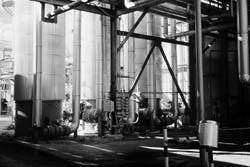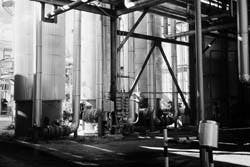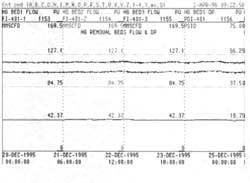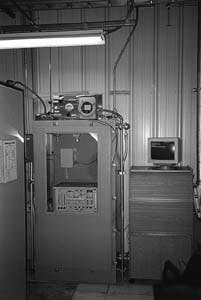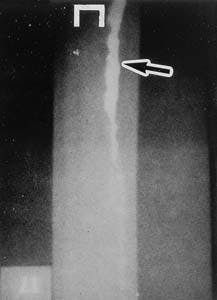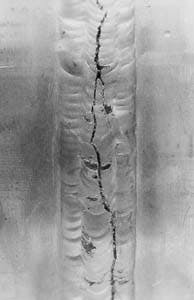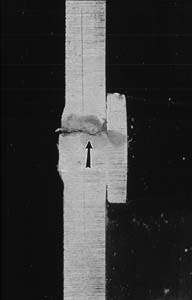TECHNOLOGY Wyoming operator solves mercury exposure problems
Dena L. Lund
Amoco Exploration & Production
Evanston, Wyo.
Anschutz Ranch East gas flows through three sulfur impregnated mercury-removal beds (Fig. 1).
Experience at Amoco Exploration & Production Co.'s Anschutz Ranch East plant in southwestern Wyoming has indicated that proper monitoring and maintenance of mercury-removal material can yield excellent removal performance.
Surrounding-seal welding of backing rings, manways, and N2 connections on coldboxes can be employed during initial design as prevention and contingency measures. Improved operation of gas pretreatment and coldbox equipment has led to sustained performance of the NGL/nitrogen-rejection unit (NRU) plant.
(Editor's note: An accompanying box discusses recent GPA Technical Committee A efforts to gather information about mercury-related problems in gas plants.)
Material degradation
The gas-processing industry is often faced with the need to remove mercury from natural gas to protect downstream equipment. Mercury exists naturally in many gas-producing reservoirs and can accumulate in low-temperature equipment.
Aluminum is a popular cryogenic operating material because it is corrosion resistant and has excellent heat-transfer properties, high weight-to-strength ratio, and ease of fabrication.1
Aluminum is susceptible, however, to both corrosion by mercury in the presence of water and to liquid metal embrittlement (LME) from mercury. The latter can result in sudden catastrophic failures.
Laboratory testing can consistently produce LME failures with 5083-aluminum welds using as little as 47 mg of mercury.2
The Anschutz Ranch East plant processes 340 MMscfd in its three-train NGL/NRU. The inlet mercury gas content has been measured at between 8 and 24 g/normal cu m. The plant has approximately 77,000 mg/day of mercury removed.
Since early 1991, this plant has experienced degradation of the sulfur-impregnated carbon mercury-removal material, change out of the mercury-removal material, liquid metal embrittlement of coldbox aluminum piping, successful coldbox repairs, and has been able to return to operation.
The plant currently produces 17,000 b/d of NGL, 175 MMscfd of sales gas, and 135 MMscfd of N2 for sales and reinjection.
Mercury removal
Plant mercury removal is performed with three parallel sulfur-impregnated carbon beds (Fig. 1). The carbon is used to adsorb the gaseous mercury that can then react with sulfur to form a stable mercuric sulfide compound that remains fixed in the bed.3
The location of the unit is between triethylene glycol (TEG) dehydration and mole sieve. Operating parameters have been determined for mercury removal that averages outlet concentrations of <0.002 g/normal cu m.
Pretreatment of the gas prior to mercury removal is absolutely critical to the performance of the removal operation. The condition of the gas entering the system can cause both short-term and long-term performance degradation.
Results of the initial carbon media change outs showed sulfur contents of approximately 1 wt % on the removed material. Virgin material averages 13-15 wt % sulfur.
This led to an investigation on the detrimental effects of contacting the mercury-removal material with process liquids.
Plant liquids, including diethanolamine (DEA; 30 wt %), TEG, and NGL were tested to establish if they can affect the sulfur content of the removal media. The testing showed that all three liquids had some capacity to extract sulfur from mercury-removal material.
In terms of relative effects, the NGL was most effective, then TEG, and finally the amine was somewhat effective in leaching out the sulfur.4
Real-time mercury concentration analysis has also led to some performance conclusions.
Temporary process upsets related to liquid separation in the pretreatment system can appear as short-term outlet concentration increases. Based on the theory of mercury removal, it is likely that liquid carry over causes a blinding of adsorption sites for the gaseous mercury resulting in a temporary rise in outlet concentration.
After the bed "dries out" the outlet concentrations return to the low outlet readings.
Mercury-monitoring historical data (Fig. 2).
Anschutz Ranch East's on-line mercury monitoring system can sample every 15 min (Fig. 3).
Operating guidelines
On-line mercury monitoring has allowed us to form the following operating guidelines:
- Liquid carryover into the carbon media must be avoided. The result is high bed pressure drops and higher-than-design outlet mercury readings.
- Mercury-removal performance is best when the process gas is heated above hydrocarbon dewpoint temperature. Consistently low mercury analysis readings are possible when the gas is 20o F. above dewpoint.
- Recycle gas from plant outlets can be mixed with inlet gas artificially to raise gas above its dewpoint by changing composition without raising the temperature. This was used as a temporary fix until process equipment could be installed to preheat the gas going to the mercury-removal unit.
- Gas containing lube oils from compression needs to be coalesced. Lube oil entrained in the gas results in higher outlet mercury readings.
- Stagnant gas lines, such as those around control loops, can build liquids. When these areas are opened up, they can release liquids and result in temporarily increased readings on bed outlets.
It is possible that the occurrences resulting in short-lived higher readings have a long-term effect as well.
To maintain overall satisfactory mercury-removal performance, several monitoring activities can be critical. Maintenance procedures should include the following:
- Regular and frequent mercury analysis of effluent from the mercury-removal unit is necessary. Regular analysis is required effectively to determine the bed performance over time, and the frequency depends on the volatility of the upstream conditions.
- Overall bed pressure drop should be monitored. Rising bed pressure drop indicates possible bed damage that may be the result of liquids carryover into the beds.
- Beds in parallel service should be monitored for flowrate and individual mercury-removal performance. Although the overall outlet content may remain low, the performance of an individual bed may be degrading or have liquid effects causing coagulation of material and reduced flow.
- Output of bed pressure drop, bed flows, and mercury concentration readings should be sent to the distributed control system where they can be monitored by operators and captured in the facility historian so that long-term data trending can be done (Fig. 2).
- There should be regular checks on operating efficiency of upstream separators. Blown seal legs on filter separators can result in liquids entrainment in process gas.
Conscientious care and monitoring of sulfur-impregnated carbon mercury-removal materials will result in excellent removal performance and identification of process conditions affecting efficiency and longevity.
Radiograph shows mercury accumulation behind a backing ring (Fig. 5).
Monitoring
Upon identification of these factors that are critical to mercury-removal effectiveness, a search began for reliable effluent mercury monitoring.
The system requirements included unattended operation, concentration readings as low as 0.001 g/normal cu m, output to a distributed control system, and interruptible service for additional monitoring points.
Several systems were reviewed during late 1991 and early 1992. At that time, no products on the market met all the requirements. Systems that were reviewed included the following:
- Gold-film electrical resistance. This form of monitoring is used by service personnel who had originally performed all plant testing. Although this equipment would meet the concentration requirement, the unit was rejected because it was not at that time adaptable to on-line service and was very labor intensive.
- Mercury photometer is used successfully to measure high concentrations of mercury. This method would require a mercury-concentration device.
A vendor was located that could put this together and automate the system, but the vendor would not provide a warranty or field service.
- Atomic fluorescence spectrometry. This unit utilizes a gold sand trap to concentrate the mercury; a carrier gas then transports the mercury past a high-intensity mercury lamp, and the fluorescence is measured with a photomultiplier tube.
The unit, the Sir Galahad PSA 10.523,5 was purchased because it is capable of accurately measuring down to 0.001 g/normal cu m, could be modified for automated sampling with output to the distributed control system, and because the vendor was willing to supply training, field service, and a warranty.
The unit was modified from portable sampling service to an on-line unit capable of sample collection every 15 min (Fig. 3).
Plant technicians deliver a service that produces regular, accurate, and repeatable mercury measurements that are captured in the plant historian and will alert operators if the readings are unusually high.
Some of the quality assurances that are in place and the difficulties that they have overcome are the following:
- A speed loop has been installed from downstream of the mercury-removal unit to downstream of the mercury outlet dust filter. This allows the monitoring point to be continuously purged and conditioned with mercury (Fig. 4 [80573 bytes]).
- A temperature bath was purchased for the calibrating mercury vapor. Best calibration results are obtained when the bath temperature is set at approximately 20o C. This temperature is approximately 5o F. below room temperature and prevents expansion of vapors during handling.
- Power source must be clean. Early erratic and poor repeatability was discovered to be caused by fluctuations in the power source. The analyzer is now set up on its own breaker separate from the auxiliary equipment to prevent interferences. Performance has improved dramatically.
- To prevent residual mercury from previous runs interfering with the signal, two blank runs are initiated by the computer between actual samples.
- Monitor operation is improved when room temperature is nearly constant.
- Minimizing the number of persons responsible for the operation and maintenance of the equipment and conducting quarterly preventive maintenance checks on equipment for cleaning and voltages have proved vital to the dependable operation of the equipment.
On-line mercury monitoring has proven to be an excellent tool for mercury-removal bed performance troubleshooting and quality assurance. The abilities to continuously monitor mercury effluent, alert operators to high readings, and capture historical data in unattended operation have proven successful.
In the first piping failure, a coldbox boot (gasket seal around valve stem penetration) blew out on Train 1 (Fig. 6).
Here is a side view of liquid metal embrittlement failure with the backing ring (Fig. 7).
Detection; failures
After the mercury-removal efficiency loss was identified, there were many concerns about the extent of intrusion, the materials most likely affected, the mechanism of mercury-related failure, and the probability that it might occur.
A Texas-based service company had some experience in mercury-related failures, crack detection, and mercury location.
During a visit to review the process, the company's metallurgist identified several aluminum lines that extend out of the coldboxes far enough to have flanges and transition to stainless steel.
Radiographs taken of the welds showed some of them with dark spots under the backing ring on the upstream side of the weld. These dark spots were possible mercury collections (Fig. 5).
The first piping failure occurred approximately 1 month later. One of the trains had been taken out of service for a defrost. During repressurization, a coldbox boot (gasket seal around valve stem penetration) blew out and released insulating perlite from the coldbox. The initial failure happened on Train 1 (Fig. 6).
After personnel were able to locate the leak and cut it out, the pipe was sent to the Amoco Production Research Center to determine cause of failure.
Report findings positively identified cause of failure as liquid-metal embrittlement of aluminum by mercury.6
Trains 2 and 3 coldbox purges came under daily chromatograph analysis for any possible hydrocarbons in the nitrogen purge gas. Eventually, the other two trains developed leaks that were detected with chromatograph analysis of purge gas.
During the course of the coldbox being entered and repairs being conducted, several key lessons became apparent for future design and repairs. Some include the following:
- Coldbox entry was impeded by the need to remove the perlite insulation. The levels of hydrocarbon in the coldbox purge gas created an atmosphere of 10% of lower explosion level (LEL) in the insulation.
After initial entry into the boxes, nitrogen sparge bars and connections were built to allow higher purge rates so that purging delays could be mnimized in the future.
- Manways were not part of the original coldbox design. The boxes had to be cut into for entry. This caused delays and required specialized contractors.
The original manufacturer then designed manways for the boxes; these were installed before the equipment was closed up again.
- Detailed blinding lists for confined space entry into the coldboxes have been catalogued for future contingency.
- Repair of cracked welds was impossible. Piping had to be replaced with fresh aluminum.
At the time of piping pressure testing, additional cracks were realized. Repairs were successful when whole piping runs were replaced from exchanger to separator.
- Radiography of welds showed mercury almost exclusively on the upstream side of the weld-backing rings. Backing rings in the repair areas have all been seal welded on the upstream side to prevent future mercury accumulation behind the backing rings (Fig. 7).
- Radiography was an excellent technique to determine the extent of mercury accumulation in the coldbox piping.
Profiles of all aluminum piping were taken in the Train 1 coldbox. There were two major piping runs in all three boxes that had the most accumulation. This is also where the failures occurred.
These two runs were completely replaced with seal-welded aluminum on all three trains.
- One set of coldbox aluminum has been put into cold storage as a contingency in case of further repairs. Aluminum of the right grade, diameter, and shape is difficult to get on short notice.
- Although aluminum heat exchangers have header designs of 5083 Al, no cracks or failures occurred in them. Internal visual inspection revealed some mercury accumulation but not in any of the weld areas.
Operational changes
Current operation of the NGL/NRU plant requires careful consideration.
All three trains have been operating since March 1992 without any additional repairs required. Several operational interventions have been put into place to prevent conditions that may contribute to mercury-related failures and to detect failures or leaks within the coldboxes.
Some of these interventions are as follows:
- In careful operation of the pretreatment system, improved water and CO2-removal and monitoring have reduced the need for the derime operation.
- Temperatures in the affected areas are maintained below -40o F. During periods of plant shutdowns, liquid levels are maintained within the separators and allowed to vapor off. This technique has been used successfully for as long as 4 days.
- Conditions that could lead to low-temperature emergency shutdowns have been identified, and operators have been trained in methods to avoid low-temperature shutdowns that could potentially result in loss of flow and warming.
- On-line chromatographs have been installed on the coldbox purge gas to determine if any slow leaks have developed in the coldboxes. These feed into the distributed control system and are monitored regularly, and data are collected in the historian.
- Pressure switches have been installed at three levels in the coldboxes as a contingency to detect possible large gas releases.
Acknowledgments
The author wishes to thank R.W. VanRiper and D.E. Erickson of Amoco E&P, Evanston, Wyo., for their contribution of examples and data for the mercury monitoring information, and E.J. Sperling of Amoco Corp., Naperville, Ill., for his continued support and use of research data and photos. Amoco wishes to thank the partners in the Anschutz Ranch East Unit for granting permission to publish this article.
References
1. Jastrebski, Zbigniew D., The Nature and Properties of Engineering Materials, 3rd Edition. New York: John Wiley & Sons Inc., 1987
2. Mcintyre, Dale R., English, Jerome J., Kobrin, Gregory "Mercury Attack of Ethylene Plant Alloys," Corrosion 89, New Orleans.
3. Calgon Carbon Quotation, request by Amoco Production Co., July 31, 1992. Permission to release granted by oral communication, Jan. 16, 1996.
4. McNamara, Dave, Calgon Carbon Corp., discussions on material testing, January 1992. Permission to release granted by oral communication, Jan. 16, 1996.
5. P.S. Analytical Ltd., "PSA Report The Sir Galahad," January 1994.
6. Sperling, Earl J., and Warke, William R., Amoco Corp., Naperville, Ill., "Metal-Induced Cracking of Aluminum Alloy Piping," PVP-Vol 288, ASME 1994.
The Author
Dena Lund is plant engineer (senior grade) at Amoco Exploration & Production's Anschutz Ranch East operation center in Evanston, Wyo. She holds a BS (1989) in chemical engineering from the University of Colorado and is a member of the Rocky Mountain Chapter of the Gas Processors Association.
Copyright 1996 Oil & Gas Journal. All Rights Reserved.
